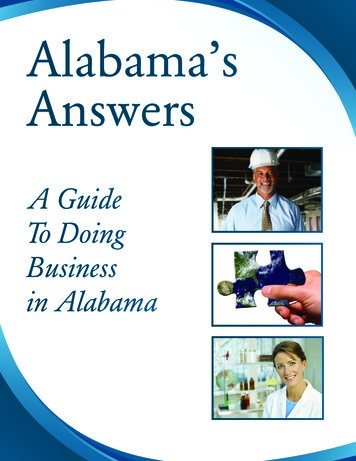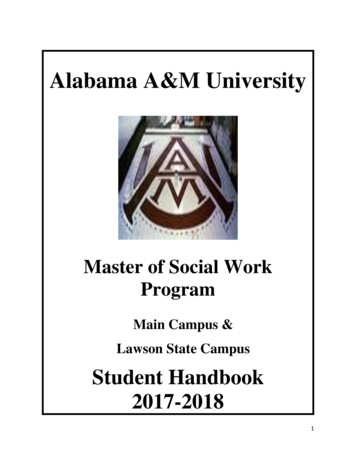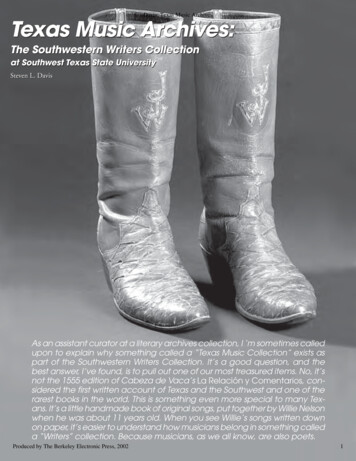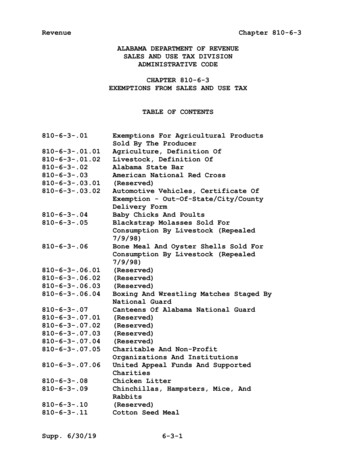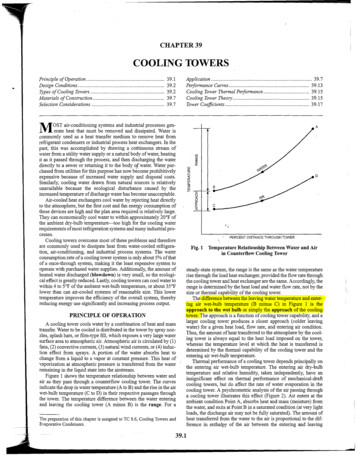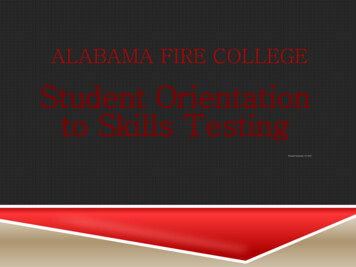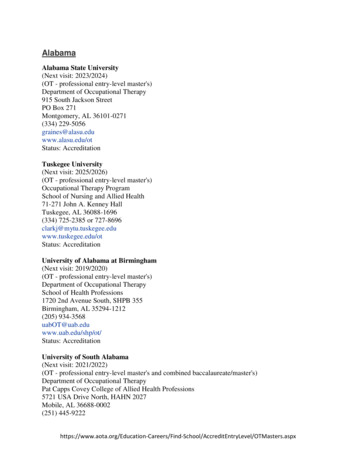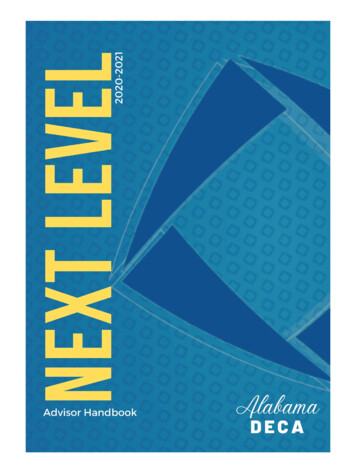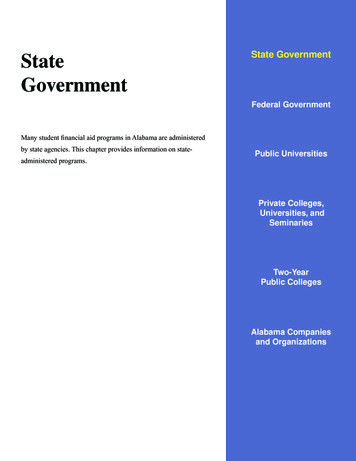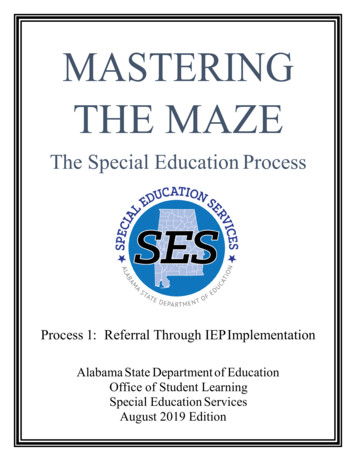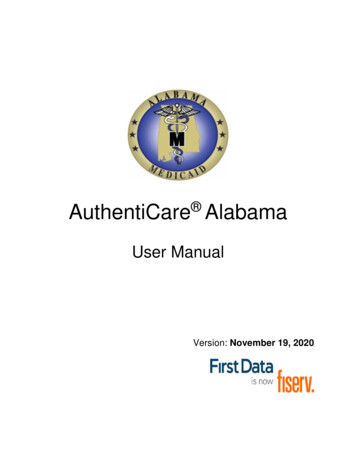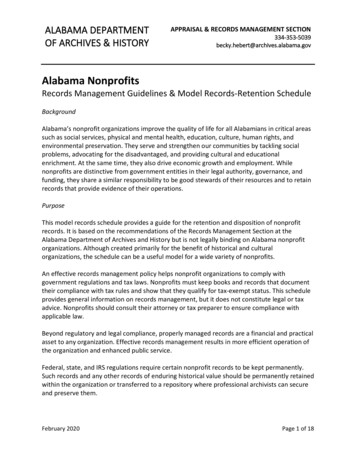
Transcription
ALABAMA DEPARTMENTOF ARCHIVES & HISTORYAPPRAISAL & RECORDS MANAGEMENT ovAlabama NonprofitsRecords Management Guidelines & Model Records-Retention ScheduleBackgroundAlabama’s nonprofit organizations improve the quality of life for all Alabamians in critical areassuch as social services, physical and mental health, education, culture, human rights, andenvironmental preservation. They serve and strengthen our communities by tackling socialproblems, advocating for the disadvantaged, and providing cultural and educationalenrichment. At the same time, they also drive economic growth and employment. Whilenonprofits are distinctive from government entities in their legal authority, governance, andfunding, they share a similar responsibility to be good stewards of their resources and to retainrecords that provide evidence of their operations.PurposeThis model records schedule provides a guide for the retention and disposition of nonprofitrecords. It is based on the recommendations of the Records Management Section at theAlabama Department of Archives and History but is not legally binding on Alabama nonprofitorganizations. Although created primarily for the benefit of historical and culturalorganizations, the schedule can be a useful model for a wide variety of nonprofits.An effective records management policy helps nonprofit organizations to comply withgovernment regulations and tax laws. Nonprofits must keep books and records that documenttheir compliance with tax rules and show that they qualify for tax-exempt status. This scheduleprovides general information on records management, but it does not constitute legal or taxadvice. Nonprofits should consult their attorney or tax preparer to ensure compliance withapplicable law.Beyond regulatory and legal compliance, properly managed records are a financial and practicalasset to any organization. Effective records management results in more efficient operation ofthe organization and enhanced public service.Federal, state, and IRS regulations require certain nonprofit records to be kept permanently.Such records and any other records of enduring historical value should be permanently retainedwithin the organization or transferred to a repository where professional archivists can secureand preserve them.February 2020Page 1 of 18
Nonprofits should cease all records destruction in the case of expected or actual litigation,governmental audit, or governmental investigation – regardless of the stated retention in thismodel document.Records Management GuidelinesCategories of RecordsRecordsRecords include all paper, electronic, or other formats that document organizational business.Permanent RecordsPermanent records are records with high administrative, fiscal, legal, and/or historical valuethat document the core functions of an organization. Examples include foundationaldocuments, board and committee meeting files, significant published materials, importantfinancial records, and records of major donations.Temporary RecordsTemporary records are kept for a designated period of time. This model records schedule listsretention periods for many of the types of record an organization creates. Organizations shoulddocument the destruction of obsolete temporary records and maintain this documentation.Transitory RecordsTransitory records are records of limited usefulness which are produced or received in thecourse of routine actions, in the preparation of other records which replace them, or forconvenient reference. Examples include: Working documents, such as drafts or preliminary versionso Exception: Where a final, official version of a document does not exist, thelatest draft should be retainedo Exception: Drafts differing substantially from the final version demonstratethe author’s decision-making process and should be retained for theirresearch significanceDuplicate records where the “official” copy is maintained elsewhereNon-auditable surplus, such as blank forms, stationery, or templatesRoutine emails such as requests for meetings and thank-you messagesNotices of internal social events, such as baby showersPage 2 of 18
Transitory records may be deleted or destroyed at any time, without documentation ofdestruction.Non-RecordsNon-records do not document an organization’s functions, transactions, or policies.Examples of non-records include: Reference materials such as catalogs, trade journals, and other publications receivedthat require no action and do not document organizational activityListserv and newsgroup messages that have no substantive business valueUnsolicited/Spam email that have no substantive business valueNon-records may be deleted or destroyed at any time, without documentation of destruction.Electronic Records MaintenanceThe content of a record, rather than its format or storage location, determines retention.Electronic records are therefore subject to the same retention requirements as the same typeof records in other formats or media. Electronic records include, but are not limited to,Microsoft Office files, email messages, digital photographs, and websites.Electronic FilesUsing a shared drive allows multiple users to access the same files. Staff members shouldensure that records are saved to the appropriate location on the shared drive. If multiple staffmembers work in the same folder on the shared drive, everyone should use the sameorganizational and naming approach to avoid confusion. Avoid using special characters such asspaces, commas, and periods in file names, and use underscores instead of spaces. Specialcharacters in file names can cause files to become corrupt and irretrievable.Whether dealing with paper or electronic records, using folders helps with organization. Whensorting electronic records, consider making the highest-level folders correspond with the typesof records listed in this records-retention schedule. Then, create sub-folders based on subject,date, event, or other organizational approach. No matter the approach, consistency is key. Organization PublicityFileso 2019 02 2019 02 06 CharityAuctiono 2018 02 01 CharityAuction PressRelease.docxo 2019 02 02 CharityAuction Invitation.pdfo 2019 02 05 CharityAuction Remarks.docxo 2019 02 06 CharityAuction Agenda.pdfPage 3 of 18
2019 02 11 DonorBreakfasto 2019 02 11 DonorBreakfast Agenda.docxo 2019 02 11 DonorBreakfast Invitation.pdfo 2019 02 11 DonorBreakfast Speech.pdf2019 02 20 FoodProgramAnnoucemento 2019 02 20 FoodProgramAnnoucement PressRelease.pdfPhotographs and Audiovisual RecordingsPhotograph and audiovisual files should be named and organized in folders for specific events.Folder names should include the event date and name. A supplementary text file, Worddocument, or other similar file within each folder can provide essential contextual informationabout the event, location, and individuals photographed or recorded.Consider storing edited photos in a separate folder entitled “Edits.” Deleting extraneous photosis highly recommended, as retaining all photos takes up storage space unnecessarily andhinders users’ ability to locate the best photos. Storing the best photo(s) of a series in anotherseparate folder enables users to better identify and preserve permanent photos. Similarly, foraudiovisual recordings, store final footage separately from raw footage.EmailEmail accounts may contain permanent, temporary, transitory, or non-record information.Although emails can be printed out, filed, and retained according to this records-retentionschedule, the organization should preferably employ an electronic records management systemthat is capable of sorting email into folders and archiving messages of long-term value. Asystem of folders helps individuals to separate transitory, temporary, and permanent recordsand can help to ensure that important records are not accidentally lost or misplaced. Foldersfor temporary records should include the appropriate destruction date of the records containedwithin. Organizations may wish to save important email messages as PDF documents so theywill not be lost in the event of staff turnover.WebsitesThe Internet Archive’s “Wayback Machine” is a webcrawler that allows users to archivewebsites and access archived websites for free. To capture an organization’s web page as itappears now, visit https://web.archive.org/ and enter the website URL under “Save Page Now.”Perform this crawl annually in order to capture snapshots of the website over time.Page 4 of 18
Destroying Temporary RecordsTemporary records may be destroyed after satisfying the organization’s retention policy,presuming no litigation, governmental audit, or governmental investigation applies or isexpected to apply to the records.This model retention schedule recommends the minimum amount of time records should bemaintained. Records may be maintained for longer if they are actively used or referenced bythe organization. Once records are no longer useful, prompt destruction eliminates bulk andreduces the time required to locate records.When destroying temporary records, ensure that the destruction is irreversible. Sensitive paperrecords should be incinerated, shredded, or otherwise destroyed so that the records areunreadable. For non-sensitive electronic records stored on network drives or other electronicdevices, deletion will suffice. To destroy sensitive electronic records, consider options such asoverwriting, degaussing for magnetic media, or physically destroying storage media.Documenting records destruction will facilitate transparency and be helpful for staff memberslooking for records that may or may not have been destroyed. Organizations can maintain a logof records destruction in a spreadsheet or fill out a destruction form for each instance ofdestruction. Document essential information such as: Destruction dateRecord typeMinimum retentionInclusive dates (the year(s) in which these records were created)Volume (the volume of the paper records being destroyed in cubic feet and/orelectronic records being destroyed in bytes)o Note: One box of copy paper equals about one cubic foot. One legal-sized filedrawer equals about two cubic feet.Preserving Permanent RecordsPermanent paper records should be stored so that they are protected from possible damage.Light, heat, humidity, and pests are common threats to paper records. Ensure the storagelocation for paper records meets the following conditions: Securityo The site is not accessible by anyone other than staff members and is protectedagainst theft.Page 5 of 18
Climate controlo The storage location temperature ranges from 65 to 75 degrees and thehumidity ranges from 45 to 55 percent, without rapid variation or fluctuation.The climate-control system is not turned off at night or over weekends.Environmental protectiono The storage site is serviced regularly for pest control.o Upper shelves are clear of light fixtures, ducts, and overhanging water pipes. Ifthis is not possible, records are not placed on upper shelves.Supervisiono The storage site is monitored regularly to check for dangers such as fire,flooding, leaks, and pests.Organizations may keep a large inventory containing hundreds or thousands of duplicatepermanent paper records, such as programs or brochures. Once the active life of these recordshas expired, save the original electronic version and, if desired, three to four paper copies forpermanent preservation. The remainder of the paper copies may be discarded.Permanent electronic records should meet the file format recommendations of the Library ofCongress, available at the following /rfs/index.html.Organizations should develop procedures for (1) backing up all permanent records held inelectronic format, (2) storing a back-up copy in an off-site, environmentally controlled location,and (3) migrating all permanent records when the system is upgraded or replaced. Backing uprecords helps to protect the organization in the event of cyberattack.If your organization has records of permanent historical value that are no longer activelyreferenced, please contact an archival institution to discuss the donation of these records.Page 6 of 18
Records-Retention ScheduleThe following retention schedule recommends the minimum amount of time each type ofrecord should be maintained. Organizations may choose to maintain records for longer if therecords are still being used or referenced by the organization. Organizations may elect to adaptthis schedule based on their own unique needs, input from legal and accounting professionals,or guidance from affiliated or umbrella national organizations. These guidelines do notconstitute legal or tax advice.GovernanceArticles of Incorporation or Charter*Disposition: PERMANENT RECORD.Organizational Bylaws and Amendments*Disposition: PERMANENT RECORD.Application and Determination Letter for Recognition of Exemption (Form 1023, 1023 EZ)(Required to be made available upon request for public inspection)Disposition: PERMANENT RECORD.Alabama Secretary of State Nonprofit Corporation Registration FilingDisposition: PERMANENT RECORD.Alabama Charitable Organization Registration and Annual Attorney General FilingDisposition: PERMANENT RECORD.Board and Committee Meeting Minutes, Agendas, and Packets*Disposition: PERMANENT RECORD.Internal Policies and Procedures (including Whistleblower and Conflict-of-Interest Policies)Disposition: PERMANENT RECORD.Files about Board Membersa. Biographical Data and Other Historical Documentation*Disposition: PERMANENT RECORD.b. Other FilesDisposition: Temporary Record. Retain 5 years after board term expires.* These records have permanent, historical value.Page 7 of 18
Fundraising and MembershipRecords of Donations (may include correspondence, pledge or commitment forms, a financialdatabase, or other record formats)a. Records of Significant Donations as Determined by the Organization (may includelarge restricted donations, multi-year donations, et al.)Disposition: PERMANENT RECORD.b. Records of Donations that Span Multiple YearsDisposition: Temporary Record. Retain 7 years after the final pledge payment.c. Records of Restricted DonationsDisposition: Temporary Record. Retain 7 years after fulfillment of the purpose of therestriction.d. Records of Planned-Giving DonationsDisposition: Temporary Record. Retain 7 years after the receipt of bequest or fulfillmentof any restricted purpose.e. Records of Other DonationsDisposition: Temporary Record. Retain 7 years after filing Form 990 or its equivalent.f. Donor Files including Donor-Relations DatabaseDisposition: Temporary Record. Retain for useful life.Fundraising and Special Event Filesa. Final Narrative Reports and Samples of Publicity Materials*Disposition: PERMANENT RECORD.b. Critical Planning DocumentationDisposition: Temporary Record. Retain 5 years.c. Lists of Attendees or Participants, Attendance Logs and Sign-in Sheets, ProgramEvaluation Forms, and other recordsDisposition: Temporary Record. Retain until completion of final narrative report. If noreport is required, retain for useful life.d. Generated Revenue and Sales ReceiptsDisposition: Temporary Record. Retain 7 years after filing Form 990 or its equivalent.* These records have permanent, historical value.Page 8 of 18
Fundraising Letters and Emails (sample of the letter)Disposition: Temporary Record. Retain for 2 years.Membership Files and Lists (if different from Donor Files)Disposition: Temporary Record. Retain for useful life.Volunteer Filesa. Volunteer Program Administrative Files (including lists of names, addresses, and workassignments; documentation of training and volunteer appreciation activities)Disposition: Temporary Record. Retain for useful life.b. Files on Individual Volunteers (including applications, work histories, publicity articles,service awards)Disposition. Temporary Record. Retain 5 years after last contact with volunteer.Programs and ActivitiesThe core work performed by an organization in service of its mission.Program Reports and Final Narratives*Disposition: PERMANENT RECORD.Program Working FilesDisposition: Temporary Record. Retain for useful life.Educational Events, Exhibitions, and Public Programming Filesa. Final Narrative Reports and Samples of Publicity Materials*Disposition: PERMANENT RECORD.b. Critical Planning DocumentationDisposition: Temporary Record. Retain 5 years.c. Lists of Attendees or Participants, Attendance Logs and Sign-in Sheets, ProgramEvaluation Forms, and other recordsDisposition: Temporary Record. Retain until completion of final narrative report. If noreport is required, retain for useful life.d. Generated Revenue and Sales ReceiptsDisposition: Temporary Record. Retain 7 years after filing Form 990 or its equivalent.* These records have permanent, historical value.Page 9 of 18
Client FilesClient files include documentation on those individuals served by nonprofits through funding,services, or other outreach programs.a. Client Administrative Files (including lists of names, addresses, and other information)Disposition: Temporary Record. Retain for useful life.(Consider potential litigation and statute of limitations in the retention of these records.)b. Minor client administrative files (including lists of names, addresses, and otherinformation)Disposition: Temporary Record. Retain until client reaches the age of majority.Communications and OutreachAnnual and Other Periodic Reports*Disposition: PERMANENT RECORD.Special Reports*Disposition: PERMANENT RECORD.Attendance and Outreach ReportsDisposition: Temporary Record. Retain for 5 years.Informational and Promotional Materialsa. Sampling of Final Product*Disposition: PERMANENT RECORD.b. Working FilesDisposition: Temporary Record. Retain for useful life.Photographs and Videosa. Selection of Best Photographs*Disposition: PERMANENT RECORD.b. Final Edited Videos*Disposition: PERMANENT RECORD.c. Other Photographs and VideosDisposition: Temporary Record. Retain for useful life.* These records have permanent, historical value.Page 10 of 18
Website and Social Media Accountsa. Website Snapshot(Take a capture of website every year using the Internet Archive Wayback Machine atarchive.org/web)Disposition: PERMANENT RECORD, maintained at archive.org/web.b. Records Documenting Major Campaigns or ProjectsDisposition: Temporary Record. Retain for 5 years.c. Records Documenting Engagement StatisticsDisposition: Temporary Record. Retain for 5 years.Managing the OrganizationStrategic PlansDisposition: PERMANENT RECORD.Routine CorrespondenceDisposition: Temporary Record. Retain 2 years.Legal Correspondencea. Significant Legal CorrespondenceDisposition: PERMANENT RECORD.b. Other Legal CorrespondenceDisposition: Temporary Record. Retain 10 years.Insurance Policies and Claims/Risk Management RecordsDisposition: Temporary Record. Retain 7 years after termination of policy or membership.Emergency and Disaster Response PlansDisposition: Temporary Record. Retain until superseded.Accident and Incident ReportsDisposition: Temporary Record. Retain 5 years.Administrative Reference FilesDisposition: Temporary Record. Retain for useful life.* These records have permanent, historical value.Page 11 of 18
Government-Relations Files (including drafts of proposed organization-sponsored legislation,requests for funding, and legislative tracking)Disposition: Temporary Record. Retain for 7 years.Computer Systems Documentation (including hardware/software specifications andwarranties)Disposition: Temporary Record. Retain until the hardware and software are no longer in useand all permanent records have been migrated to a new system.FinancesAudit ReportDisposition: PERMANENT RECORD.Annual Financial Statements (including balance sheets, income statements, statements ofcash flow)Disposition: PERMANENT RECORD.Year-End Budget ReportsDisposition: PERMANENT RECORD.General Ledg
Alabama Charitable Organization Registration and Annual Attorney General Filing Disposition: PERMANENT RECORD. B
